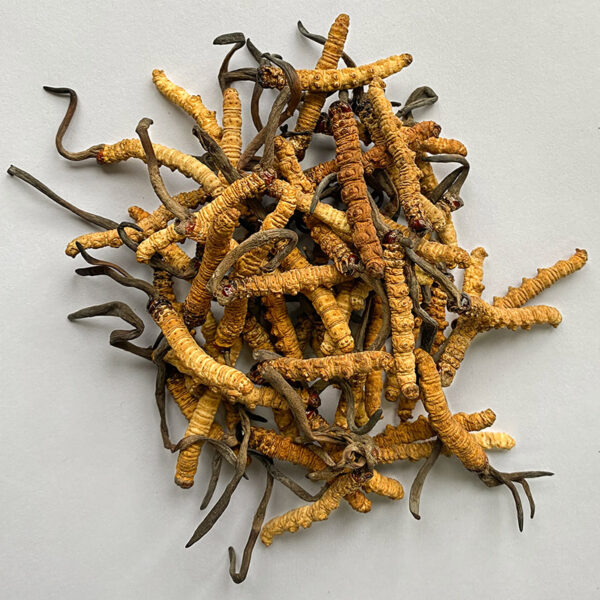Wild Cordycep Sinensis
Cordyceps sinensis, known locally in Bhutan as “Yartsa Guenboob” (summer grass-winter worm), is a unique and highly valued fungus with a fascinating life cycle and significant medicinal properties.
Description
Cordyceps sinensis is an entomopathogenic fungus, meaning it grows on and derives nutrients from insects. Specifically, it parasitizes the larvae of ghost moths while they are buried underground. The fungus germinates inside the larva, slowly killing it and eventually mummifying it. In the spring, a fruiting body (stroma) emerges from the deceased larva’s head and grows upward, resembling a blade of grass. This fruiting body is the part that is harvested and used medicinally.
Appearance
The Caterpillar: The dried caterpillar is yellowish-brown, about 3-5 cm long, and has a cylindrical shape with distinct segments.
The Fruiting Body: The stroma is dark brown or black, slender, and usually 4-10 cm long. It has a club-shaped head containing the reproductive spores.
Habitat
Cordyceps sinensis thrives in the high-altitude alpine meadows and grasslands of the Himalayas, typically found at elevations between 3,000 and 5,000 meters. In Bhutan, it is commonly found in the northern and northwestern regions, including places like Lingshi, Laya, and Lunana.
Medicinal Uses and Benefits
Cordyceps sinensis has been used in traditional Tibetan and Chinese medicine for centuries and is believed to have a wide range of health benefits, including:
Boosting the immune system: Cordyceps is thought to stimulate the immune system and enhance the body’s defense against infections.
Improving respiratory function: It is traditionally used to treat respiratory conditions like asthma, bronchitis, and coughs.
Enhancing athletic performance: Cordyceps is believed to increase energy levels, stamina, and oxygen utilization, making it popular among athletes.
Kidney and liver support: It is used to support kidney and liver function and may help protect against damage.
Anti-inflammatory properties: Cordyceps is thought to have anti-inflammatory effects, which could be beneficial for conditions like arthritis.
Adaptogenic properties: It is considered an adaptogen, helping the body cope with stress and fatigue.
Grading
Grading A1
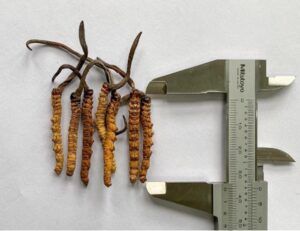
100% Bhutanese Wild Cordycep Sinensis
In 1 kilogram there are 3000 to 3500 pieces, where its average length is 37 mm and its average circumference is 4mm.
Grading A2
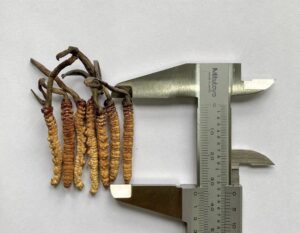
100% Bhutanese Wild Cordycep Sinensis
In 1 kilogram there are 3500 to 4000 pieces, where its average length is
34.5 mm and its average circumference is 3.5mm.
Grading A3
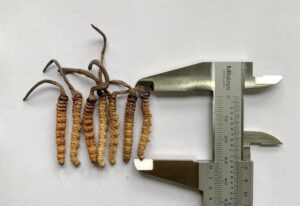
100% Bhutanese Wild Cordycep Sinensis
In 1 kilogram there are 4000 to 4500 pieces, where its average length is 34 mm and its average circumference is 3mm
Grading B1
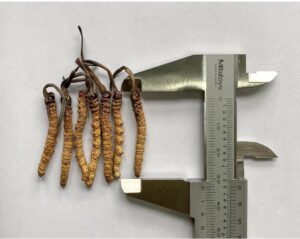
100% Bhutanese Wild Cordycep Sinensis
In 1 kilogram there are 4500 to 5000 pieces of Cordyceps, where its average length is 33 mm and its average circumference is 3mm.
Grading B2
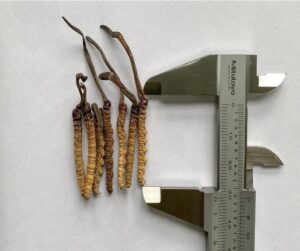
100% Bhutanese Wild Cordycep Sinensis
In 1 kilogram there are 5000 to 6000 pieces of Cordyceps, where its average length is 31 mm and its average circumference is 2mm.
Grading B3

100% Bhutanese Wild Cordycep Sinensis
In 1 kilogram there are 6000 to 7000 pieces of Cordyceps, where its average length is 29 mm and its average circumference is 2mm.
Grading C
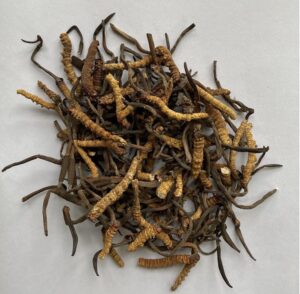
100% Bhutanese Wild Cordycep Sinensis
These Cordyceps are hollow and broken but it still contains several benefits.
$360.00 – $3,600.00
Visit Us
-
Langjophakha,
Thimphu, Bhutan - +975 17111808/ 77696969
- [email protected]
OPENING HOURS
- Monday - Friday:
- 10:00AM - 5:00PM
- Saturday - Sunday:
- 10:00AM - 1:00PM
Join our Community
Get updates on special offers and receive your first gifts us!

